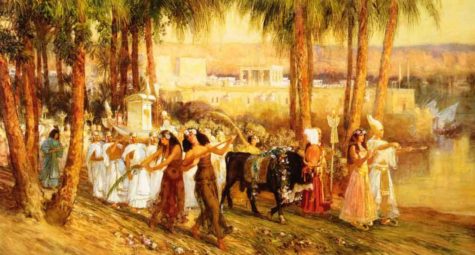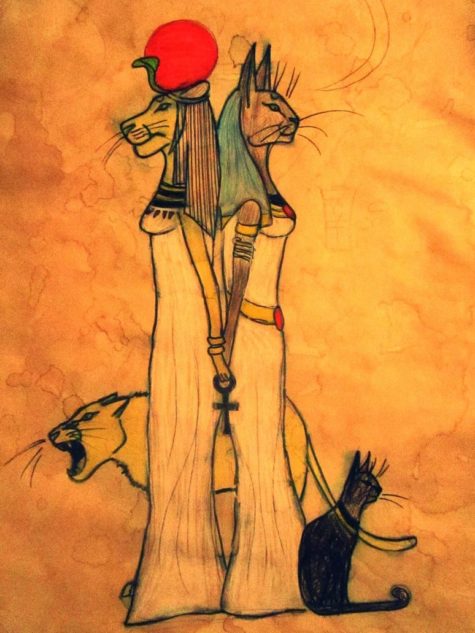Egyptian Festivities
When Egypt became part of the Roman Empire, Greek merchants brought the worship of Isis from Alexandria to Rome and invoked Her as inventor of the sail, patron of navigation, and ruler of the waves.
Possibly the most well known Isiac festival of the Roman world was the Navigium Isidis, celebrated on the 5th of March. As part of the festivities, a a festive carnival procession was performed in honor of Isis, and the Vessel of Isis, laden with offerings of precious spices and milk libations, is launched.
Here is a colorful and detailed eye-witness account of the procession and the ceremony:
Soon the sun of gold arose and sent the clouds of thick night flying; and lo, a crowd of people replenished the streets, filing in triumphal religious procession. It seemed to me that the whole world, independent of my own high spirits, was happy. The dusky clouds were routed; and the heavens shone with clear sheer splendor of their native light.
Presently the vanguard of the grand procession came in view. It was composed of a number of people in fancy dress of their own choosing; a man wearing a soldier’s sword-belt; another dressed as a huntsman, a thick cloak caught up to his waist with hunting knife and javelin; another who wore gilt sandals, a wig, a silk dress and expensive jewelry and pretended to be a woman.
Then a man with heavy boots, shield, helmet and sword, looking as though he had walked straight out of the gladiators’ school; a pretended magistrate with purple robe and rods of office; a philosopher with cloak, staff, clogs and billy-goat beard; a bird catcher, carrying lime and a long reed; a fisherman with another long reed and a fish hook.
Oh, yes, and a tame she-bear, dressed like a woman, carried in a sedan chair; and an ape in a straw hat and a saffron-coloured Phrygian cloak with a gold cup grasped in its paws – a caricature of Jupiter’s beautiful cup-bearer Ganymede.
Finally an ass with wings glued to its shoulders and a doddering old man seated on its rump; you would have laughed like anything at that pair, supposed to be Pegasus and Bellerophon. These fancy-dress comedians kept running in and out of the crowd, and behind them came the procession proper.
At the head walked women crowned with flowers, who pulled more flowers out of the folds of their beautiful white dresses and scattered them along the road; their joy in the Saviouress appeared in every gesture.
Next came women with polished mirrors tied to the backs of their heads, which gave all who followed them the illusion of coming to meet the Goddess, rather than marching before her.
Next, a party of women with ivory combs in their hands who made a pantomime of combing the Goddess’s royal hair, and another party with bottles of perfume who sprinkled the road with balsam and other precious perfumes; and behind these a mixed company of women and men who addressed the Goddess as “Daughter of the Stars” and propitiated her by carrying every sort of light – lamps, torches, wax-candles and so forth.
Next came musicians with pipes and flutes, followed by a party of carefully chosen choir-boys singing a hymn in which an inspired poet had explained the origin of the procession.
The temple pipers of the great god Serapis were there too, playing their religious anthem on pipes with slanting mouth-pieces and tubes curving around their right ears; also a number of beadles and whiffers crying: “Make way there, way for the Goddess!”
Then followed a great crowd of the Goddess’s initiates, men and women of all classes and every age, their pure white linen clothes shining brightly. The women wore their hair tied up in glossy coils under gauze head-dresses; the men’s heads were completely shaven, representing the Goddess’s bright earthly stars, and they carried rattles of brass, silver and even gold, which kept up a shrill and ceaseless tinkling.
The leading priests, also clothed in white linen drawn tight across their breasts and hanging down to their feet, carried the oracular emblems of the deity. The High Priest held a bright lamp, which was not at all like the lamps we use at night banquets; it was a golden boat-shaped affair with a tall tongue of flame mounting from a hole in the centre.
The second priest held an auxiliaria, or sacrificial pot, in each of his hands – the name refers to the Goddess’s providence in helping her devotees. The third priest carried a miniature palm-tree with gold leaves, also the serpent wand of Mercury. The fourth carried the model of a left hand with the fingers stretched out, which is an emblem of justice because the left hand, with its natural slowness and lack of any craft or subtlety, seems more impartial than the right. He also held a golden vessel, rounded in the shape of a woman’s breast, from the nipple of which a thin stream of milk fell to the ground. The fifth carried a winnowing fan woven with golden rods, not osiers. Then came a man, not one of the five, carrying a wine-jar.
Next in the procession followed those deities that deigned to walk on human feet. Here was the frightening messenger of the gods of Heaven, and of the gods of the dead: Anubis with a face black on one side, golden on the other, walking erect and holding his herald’s wand in one hand, and in the other a green palm branch. Behind, danced a man carrying on his shoulders, seated upright, the statue of a cow, representing the Goddess as the fruitful Mother of us all.
Then along came a priest with a box containing the secret implements of her wonderful cult. Another fortunate priest had an ancient emblem of her godhead hidden in the lap of his robe; this was not make in the shape of any beast, wild or tame, or any bird or human being, but the exquisite beauty of its workmanship no less than the originality of its design called for admiration and awe.
It was a symbol of the sublime and ineffable mysteries of the Goddess, which are never to be divulged a small vessel of burnished gold, upon which Egyptian hieroglyphics were thickly crowded with a rounded bottom, a long spout, and a generously curving handle along which sprawled an asp, raising his head and displaying its scaly, wrinkled, puffed-out throat…
Meanwhile the pageant moved slowly on and we approached the sea shore… There the divine emblems were arranged in due order and there with solemn prayers the chaste lipped priest consecrated and dedicated to the Goddess a beautifully built ship, with Egyptian hieroglyphics painted over the entire hull; but first he carefully purified it with a lighted torch, an egg and sulphur. The sail was shining white linen, inscribed in large letters with the prayer for the Goddess’s protection of shipping during the new sailing season.
The long fir mast with its shining head was now stepped, and we admired the gilded prow shaped like the neck of Isis’s sacred goose, and the long, highly-polished keel cut from a solid trunk of citrus-wood. Then all present, both priesthood and laity, began zealously stowing aboard winnowing-fans heaped with aromatics and other votive offerings and poured an abundant stream of milk into the sea as a libation.
When the ship was loaded with generous gifts and prayers for good fortune, they cut the anchor cables and she slipped across the bay with a serene breeze behind her that seemed to have sprung up for her sake alone. When she stood so far out to sea that we could no longer keep her in view, the priests took up the sacred emblems again and started happily back towards the temple, in the same orderly procession as before.
On our arrival the High Priest and the priests who carried the oracular emblems were admitted into the Goddess’s sanctuary with other initiates and restored them to their proper places. Then one of them, known as the Doctor of Divinity, presided at the gate of the sanctuary over a meeting of the Shrine-bearers, as the highest order of the priests of Isis are called. He went up into a high pulpit with a book and read out a Latin blessing upon “our liege lord, the Emperor, and upon the Senate, and upon the Order of Knights, and upon the Commons of Rome, and upon all sailors and all ships who owe obedience to the aforesaid powers.”
Then he uttered the traditional Greek formula, “Ploeaphesia”, meaning that vessels were now permitted to sail, to which the people responded with a great cheer and dispersed happily to their homes, taking all kinds of decorations with them; such as olive boughs, scent shrubs and garlands of flowers, but first kissing the feet of a silver statue of the Goddess that stood on the temple steps.
From: The Golden Ass
In ancient Egypt, the saving of mankind was commemorated every year on the feast day of Hathor/Sekhmet (Jan 7). Everyone drank beer stained with pomegranate juice and worshiped
“the Mistress and lady of the tomb,
gracious one,
destroyer of rebellion,
mighty one of enchantments“
A statue of Sekhmet was dressed in red facing west, while Bast was dressed in green and faced east. Bast was sometimes considered to be Sekhmet´s counterpart (or twin depending on the legend), and in the festival of Hathor they embodied the duality central to Egyptian mythology. Sekhmet represented Upper Egypt while Bast represented Lower Egypt.
- Note:
The dates for this feast day vary widely. In the book, Festivals of Light, August 7 is given as the Inebriety of Hathor, with a similar description of the festivities.
The Egyptians called it, Night of a Teardrop. On this night, (June 16) when the moon rose high in it’s sky, Isis shed one blessed and mournful tear for her beloved, Osiris. That precious tear was then collected into the palm of the Goddess of the River Nile, Satis, in which she placed it within’, causing the Nile to bring forth it’s annual flood. Even in Isis’ pain, something divine came forth.

The Nile River has always been the backbone of Egypt. The mighty river flows for some 4,000 miles from the mountains of Equatorial Africa (Blue Nile) and Lake Victoria (White Nile) before it empties into the Mediterranean Sea. Were it not for the Nile River, Egyptian civilization could not have developed, as it is the only significant source of water in this desert region. It would flood each year, bringing in silt-laden waters; when the waters receded the silt would stay behind, fertilizing the land,the silt would be helpful for growing crops.
If a flood was too large it would wash over mud dykes protecting a village. A small flood or no flood at all would mean famine. A flood must be of just the right intensity for a good season.
The Ancient Egyptians used an object called a nilometer to record how high the Nile was during the year. The nilometer was a staircase that proceeded down into the Nile with marks on it so the Egyptians knew how far the river rose. Nilometers were placed at various points along the Nile in order to monitor the changes in the water level. It was recorded that at the start of the flooding the clear waters would turn a turbid red.
As the agriculture of Egypt revolved around the Nile, so did the social life of the ancient Egyptians. During inundation when there was less to do, people had more time for recreational activities, they played games, held sporting tournaments and regularly feasted.
When the River Nile receded the appearance of the land had radically changed and there was a great rush to restore boundaries. There were many disputes as markers had moved, banks had collapsed, and distinguishable features had disappeared.
~Compiled from various sources
Sham el-Nisim is an Egyptian national holiday marking the beginning of spring. It always falls on Easter Monday, the day after the Eastern Christian Easter (following the custom of the largest Christian denomination in the country, the Coptic Orthodox Church).
Despite the Christian-related date, the holiday is celebrated by Egyptians of all religions, so it is considered a national festival, rather than a religious one. The main features of the festival are:
- People spend all day out picnicking in any space of green, public gardens, on the Nile, or at the zoo.
Traditional food eaten on this day consists mainly of fesikh (a fermented, salted and dried grey mullet), lettuce, scallions or green onions, tirmis, and colored boiled eggs.
The name of the holiday is derived from the Egyptian name of the Harvest Season, known as Shemu, which means a day of creation. According to annals written by Plutarch during the 1st century AD, the Ancient Egyptians used to offer salted fish, lettuce, and onions to their deities on this day.
After the Christianization of Egypt, the festival became associated with the other Christian spring festival, Easter. Over time, Shemu morphed into its current form and its current date, and by the time of the Islamic conquest of Egypt, the holiday was settled on Easter Monday. The Islamic calendar being lunar and thus unfixed relative to the solar year, the date of Sham el-Nessim remained on the Christian-linked date.
As Egypt became Arabized, the term Shemu found a rough phono-semantic match in Sham el-Nessim, or “Smelling/Taking In of the Zephyrs,” which fairly accurately represents the way in which Egyptians celebrate the holiday.
In his book, Manners and Customs of the Modern Egyptians, Edward William Lane wrote in 1834:
A custom termed ‘Shemm en-Nessem’ (or the Smelling of the Zephyr) is observed on the first day of the Khamaseen. Early in the morning of this day, many persons, especially women, break an onion, and smell it; and in the course of the forenoon many of the citizens of Cairo ride or walk a little way into the country, or go in boats, generally northward, to take the air, or, as they term it, smell the air, which on that day they believe to have a wonderfully beneficial effect. The greater number dine in the country or on the river. This year they were treated with a violent hot wind, accompanied by clouds of dust, instead of the neseem; but considerable numbers, notwithstanding, went out to ‘smell’ it.






